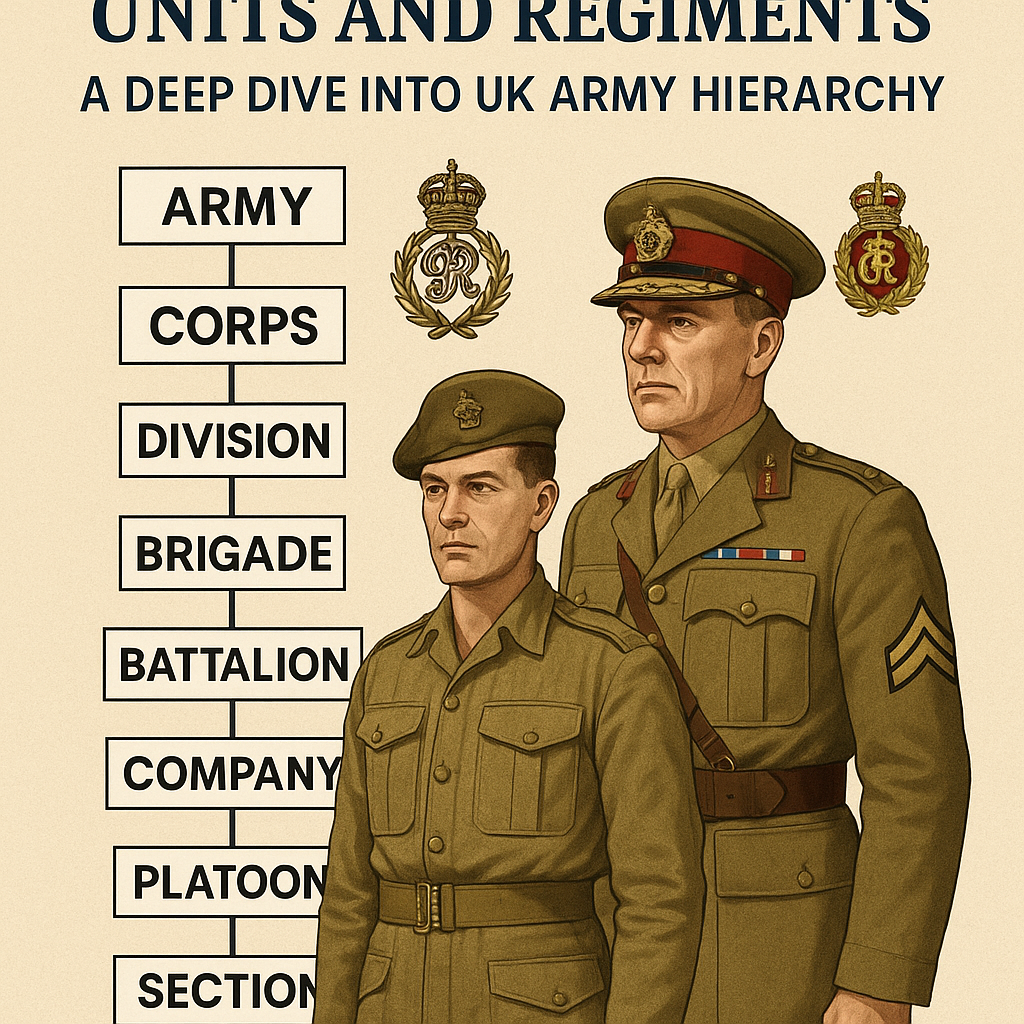
WW2 British Units and Regiments: A Deep Dive into UK Army Hierarchy
Published on Apr 30, 2025
WW2 British Units and Regiments: A Deep Dive into UK Army Hierarchy
When you think of World War II, the might of the British Army played a crucial role in the Allies' victory. From the beaches of Normandy to the deserts of North Africa, British units and regiments stood resilient and well-organized, driven by a complex but effective military hierarchy. In this article, we will uncover the inner workings of WW2 British regiments, spotlighting key roles such as the General of the Army UK and the Regimental Sergeant Major rank and their historical significance.
Understanding British Army Structure During WW2
The British Army during World War II was structured around a tiered command system, with clear distinctions between ranks and responsibilities. The foundation of this structure lay in its regiments, each steeped in tradition and regional identity.
What is a Regiment?
A regiment is one of the oldest and most prestigious military units in the British Army. Each regiment usually represented a specific geographical area of the UK, with unique insignias, uniforms, and customs. While battalions are operational units, regiments often serve as administrative or ceremonial bodies overseeing one or more battalions.
Key Units in the British Army During WW2
British Army formations typically followed this order:
- Section (10 soldiers)
- Platoon (30–40 soldiers)
- Company (100–120 soldiers)
- Battalion (800–1,000 soldiers)
- Brigade (3–4 battalions)
- Division (3 brigades)
- Corps
- Army
This structure ensured a disciplined command chain, making operations smoother and more effective even during large-scale campaigns.
Famous WW2 British Regiments
Several regiments gained legendary status during World War II:
- The Parachute Regiment – Known for airborne operations behind enemy lines.
- The Royal Tank Regiment – Britain’s elite armoured unit during the North African campaign.
- The Black Watch – A Highland regiment with centuries of service.
- The Coldstream Guards – Played a vital role in the European theatre.
Each of these regiments carried its own badge and insignia, contributing to the rich tapestry of UK army logos and heraldry.
Role of the General of the Army UK
At the top of the British Army command sat high-ranking officers, including the General of the Army UK. While the British military doesn't use the exact title "General of the Army" in the American sense, the equivalent in British terms would be Field Marshal—the highest rank, rarely bestowed.
Responsibilities of a General (Field Marshal):
- Strategic planning for entire theatres of war
- Oversight of multiple corps and armies
- Coordination with Allied forces (e.g., U.S. or French armies)
- High-level diplomatic and military decisions
Notable Field Marshals of WW2 included:
- Bernard Montgomery – Led British forces in North Africa and Normandy.
- Alan Brooke – Chief of the Imperial General Staff, essentially the head of the British Army.
These figures were pivotal in shaping the Allies’ victory strategy.
The Regimental Sergeant Major Rank Explained
At the other end of the hierarchy, yet equally important, was the Regimental Sergeant Major (RSM). The RSM is the senior non-commissioned officer (NCO) within a battalion or regiment and plays a vital role in maintaining discipline and morale.
Duties of a Regimental Sergeant Major:
- Enforcing standards of dress, behaviour, and performance
- Advising the commanding officer
- Training oversight
- Leading by example in combat and conduct
The Regimental Sergeant Major rank held immense respect and was often the backbone of a battalion’s daily functioning. They were the voice of the soldiers and the eyes and ears of the officers.
Symbols of Rank and Insignia
During WW2, uniforms were not just practical—they carried meaning. Rank insignia and regimental logos were displayed prominently on sleeves, lapels, and hats, offering visual cues about a soldier’s role, unit, and experience.
Key identifiers included:
- Crown and pips for officers
- Warrant officer badges for senior NCOs
- Cap badges unique to each regiment
Many of these historical insignia are now available on Paddelaters.com, a trusted source for collectors and enthusiasts of British military history.
Why Understanding WW2 British Army Structure Matters
Whether you're a history buff, reenactor, or someone interested in vintage military gear, understanding the WW2 British military hierarchy gives deep insight into how wars were fought and won. The blend of tradition and tactical organization made the British Army a formidable force.
Moreover, learning about roles like the General of the Army UK and the Regimental Sergeant Major rank helps you appreciate the human element behind every military maneuver.
Explore Authentic WW2 British Military Apparel and Badges
At Paddelaters.com, we specialize in curating a rich collection of authentic and replica British uniforms, patches, and insignia. Whether you're looking for the UK army logo, a Field Marshal's cap badge, or an RSM’s chevron, our catalogue celebrates the bravery and legacy of Britain’s armed forces.
Conclusion
The British Army's structure during World War II was a fine-tuned system of ranks, regiments, and traditions. From the lofty responsibilities of generals to the ground-level grit of sergeant majors, each role was vital. By studying these units and understanding their ranks, we not only honour the past but also preserve it for future generations.
